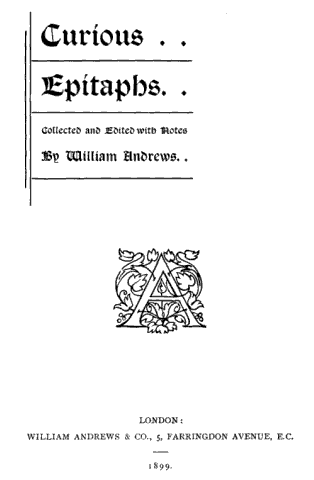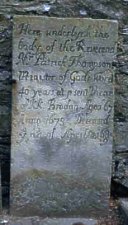

[note just one chapter is included from this interesting work - the photographs are mine and obviously not included in the text]
SEVERAL of the churchyards in the Isle of Man contain monuments of more than local interest, and will repay a careful inspection. The ancient graveyard of Kirk Braddan, surrounded with beautiful trees, and situated in a secluded spot not far distant from the busy town of Douglas, is the most celebrated. It not only contains numerous modern tombstones of unusual interest, but some Runic monuments of importance which have given rise to some strange stories, and suggested a theme for the poet and a study for the antiquary.

An old time-worn stone near the chief door of the church attracts much attention. It states :-
Here underlyeth ye body of ye Reverend Mr. PATRICK THOMPSON, minister of God's word forty years, at present Vicar of Kirk Braddan. Aged 67 anno 1678. Deceased ye 24th of April 1689.
It will be seen from the foregoing that the stone was prepared eleven years prior to the death of the vicar.
Some of the gravestones bear records of longevity, the most important being the following :-
In memory of PATRICK M'CARREY of Douglas, who departed this life the 9th December 1851, aged 102 years . also in memory of JANE M'CARREY, alias Leech, wife of the above-named PATRICK M'CARREY, who departed this life the 19th December 1851, aged 100 years. They lived together upwards of 70 years.
It will be noticed that although the pair had lived together as man and wife for three score years and ten, the widow only lived ten days after the death of her husband. On many of the tombstones the maiden name of the wife is given, and preceding it is the word alias.
Major Wilks, on his retirement from the Governorship of St. Helena, where he had the charge of the Emperor Napoleon, settled in the Isle of Man. He brought with him a black servant, who died a few years after leaving his native country. He was buried in this graveyard, and over his remains Major Wilks erected a stone bearing an inscription as follows
SAMUEL ALLEY,An African, and native of St. Helena,
Died 28th May 1822, aged 18 years,
Born a slave, and exposed
In early life to the corrupt influence
Of that unhappy state, he became
A model of Truth and Probity, for
The more fortunate of any country
Or condition.
This stone is erected by a grateful
Master to the memory of a faithful Servant,
who repaid the boon of
Liberty with unbounded attachment.
Governor Wilks was a gentleman of high character, personable and courtier-like manners. He was a writer of some ability, and was the author of a " History of the Mahratta War," which Napoleon read and admired. The exEmperor greatly esteemed the Governor, and his departure from St. Helena, where it is said that he made many wise and lastino- improvements, was much recretted. Shortly prior to leaving the island, Governor Wilks introduced his daughter to Napoleon, who, it is reported, looked at her with a pleasing smile and said, " I have long heard from various quarters of the superior elegance and beauty of Miss Wilks; but now I am convinced from my own eyes that report has scarcely done her sufficient justice," and concluded by most politely bowing to Miss Wilks. In course of conversation he said, " You will be very glad to leave this island." She replied "Oh no,sire; I am very sorry to go away." "Oh! Mademoiselle, I wish I could change places with you. " He presented her with a bracelet in memory of her visit. She subsequently became Lady Buchan, and died in May, 1888, at the advanced age of ninety-one years; and at the time of her death it was stated that " she was one of the last surviving persons who had a distinct recollection of the first Napoleon."
There is a curious bit of lore connected with the estate of Governor Wilks in the Isle of Man ; it is situated not far from Kirk Braddan, and called Kirby, a name corrupted from two Manx words, " Cur Bee," meaning " Give food." In the olden days the owner of the estate had to provide bed and board to the Bishop on his journey to and from England, and from this circumstance is derived its name.
[suggest from Kirk by - church place as more likely !]
In the churchyard rest the mortal remains of the brother of Mrs. William Wordsworth, Captain Henry Hutchinson. The poet Wordsworth wrote the epitaph which appears on his tombstone. The inscription can only be read with great difficulty, and in a few years will be effaced by the effects of the weather on the tender stone. The following is a literal copy of the epitaph, and perhaps the only one which has been printed ..-
In memory of
HENRY HUTCHINSON,
born at Penrith, Cumberland,
14th June 1769.
At an early age he entered
upon a Seafaring life in the
course of which, being of a
thoughtful mind, he attained
great skill, and knowledge
of his Profession, and endured
in all climates severe
hardships with exemplary
courage & fortitude. The
latter part of his life, was
passed with a beloved Sister
upon this Island. He died at
Douglas the 23rd of May 1839,
much lamented by his Kindred
& Friends who have erected
this stone to testify their
sense of his mild virtues
& humble piety.
Hutchinson wrote poetry of much merit, and one of his sonnets is included in the works of Wordsworth. It is autobiographical in its character, and is as follows :-
From early youth I ploughed the restless Main,
My mind as restless and as apt to change ;
Through every clime and ocean did I range,
In hope at length a competence to gain ;
For poor to Sea I went, and poor I still remain.
Year after year I strove, but strove in vain,
And hardships manifold did I endure,
For Fortune on me never deigned to smile
Yet I at last a resting place have found,
With just enough life's comforts to procure,
In a snug Cove on this our favoured Isle,
A peaceful spot where Nature's gifts abound
Then sure I have no reason to complain,
Though poor to Sea I went, and poor I still remain.
Inside the church there is another monument of some literary interest, placed to the memory of the Rev. John Kelly, LL.D.,J.P., etc., Rector of Copford, near Colchester. He was the compiler of a polyglot dictionary in the Manx, Gaelic, and Erse languages. The work has quite a romantic history. We are told, " whilst conveying the manuscript, on which he had spent much time and care, to England, he was wrecked between Ramsey and Whitehaven, but, with great fortitude, he supported himself on the sea, and held the manuscript at arm's-length above the waters for the space of five hours." Several other interesting tablets are inside the church.
There is a striking monument in the churchyard to the memory of Lord Henry Murray, fifth son of the Duke of Atholl. The inscription states" This sincere testimonial of affection and deep regret for their commander and their friend is erected by the officers of the regiment." He was the Lieutenant -Colonel Commandant of the Royal Manx Fencibles, and died in 1805, at the age of thirty-eight years.
In the Kirk Braddan Cemetery, situated not far from the old churchyard, is buried John Martin, the celebrated artist, and brother of the notorious Jonathan Martin, who set fire to York Minster, and the eccentric William Martin, the antiNewtonian philosopher. Martin painted some remarkable pictures, and was a man of genius. He was one of the most popular artists of his day, although he was never a member of the Royal Academy. Accordiny to the local guide-books, "his latest productions,-'The Great Day of His Wrath,' ' The Day of Judgment,' and 'The Plains of Heaven,' -owe much of their atmospheric grandeur and scenery to the residence of the painter on this island." A marble slab on a large square vault bears the following inscription :-
In memory of JOHN MARTIN, historical painter, born at Flaydon Bridge, Northumberland, 19th July 1789, died at Douglas, Isle of Man, '7th February 1854.
Martin was a man greatly esteemed, and did much to promote intercourse between men and women devoted to literature, science, and art.
Mr. Samuel Carter Hall, in his pleasant "Memoirs of Great Men," supplies a genial sketch of this artist. " Martin, like so many other artists," says Mr. Hall, " had a terrible wrestle with adversity on his way to fame. I remember his telling me that once he 'owned' a shilling; it was needful to hoard it, but, being very hungry, he entered a baker's shop to buy a penny loaf. To his shame and dismay, he found the shilling was a bad one. ' So long afterwards,' added the painter, then at the realisation of his hopes and aims, 'when I had a shilling, I took care to get it changed into penny-pieces.'"
A gravestone in the churchyard of Santon Parish Church contains the following curious inscription:-
Here, friend, is little Daniel's tomb
To Joseph's age he did arrive.
Sloth killing thousands in their bloom,
While labour kept poor Dan alive.
How strange, yet true, full seventy years
Was his wife happy in her tears !
DANIEL TEAR died 9th December 1707, aged 110 years.
|
|
||
|
|
||
|
|
||